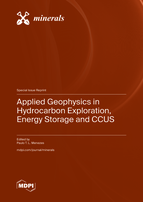Applied Geophysics in Hydrocarbon Exploration, Energy Storage and CCUS
A special issue of Minerals (ISSN 2075-163X). This special issue belongs to the section "Mineral Exploration Methods and Applications".
Deadline for manuscript submissions: closed (31 May 2023) | Viewed by 15918
Special Issue Editor
2. Petrobras, Rio de Janeiro 20031-912, Brazil
Interests: applied geophysics; petroleum exploration; exploration geophysics
Special Issues, Collections and Topics in MDPI journals
Special Issue Information
Dear Colleagues,
Since oil and gas exploration began, applied geophysics methods have developed a fundamental role in industry, permeating applications in all life stages of hydrocarbon reservoirs.
Over this period, technological advances in many areas of applied geophysics have allowed for better subsurface imaging and characterization of reservoirs, producing positive impacts in terms of reduced exploratory costs and especially in the optimization of exploration, aiming at a lower environmental impact in energy production and a more sustainable hydrocarbon industry. Notably, carbon capture, utilization and storage (CCUS) projects play an essential role in decarbonization efforts as countries worldwide aim to reduce emissions from the energy industry. This, together with energy storage in deep reservoirs (hydrogen, compressed air, etc.) are the key vectors of today’s environmental and energy policies.
Thus, a platform to trade and debate this new knowledge for the future of hydrocarbon exploration, CCUS applications and energy storage (including geothermal) is essentially required, which is the aim of this Special Issue.
Our focus in this Special Issue includes geophysical method applications from regional exploration to reservoir characterization and monitoring as well as carbon and energy storage solutions. We especially welcome the submission of case studies, reviews, new developments, and the integration of methodologies. We have divided the themes into three sections.
Section 1: Exploration case studies, from regional to local scales.
Section 2: Reservoir characterization and monitoring.
Section 3. Applied geophysics in carbon capture, utilization and storage (CCUS) and energy storage.
We look forward to your contributions to this Special Issue.
Dr. Paulo T. L. Menezes
Guest Editor
Manuscript Submission Information
Manuscripts should be submitted online at www.mdpi.com by registering and logging in to this website. Once you are registered, click here to go to the submission form. Manuscripts can be submitted until the deadline. All submissions that pass pre-check are peer-reviewed. Accepted papers will be published continuously in the journal (as soon as accepted) and will be listed together on the special issue website. Research articles, review articles as well as short communications are invited. For planned papers, a title and short abstract (about 100 words) can be sent to the Editorial Office for announcement on this website.
Submitted manuscripts should not have been published previously, nor be under consideration for publication elsewhere (except conference proceedings papers). All manuscripts are thoroughly refereed through a single-blind peer-review process. A guide for authors and other relevant information for submission of manuscripts is available on the Instructions for Authors page. Minerals is an international peer-reviewed open access monthly journal published by MDPI.
Please visit the Instructions for Authors page before submitting a manuscript. The Article Processing Charge (APC) for publication in this open access journal is 2400 CHF (Swiss Francs). Submitted papers should be well formatted and use good English. Authors may use MDPI's English editing service prior to publication or during author revisions.
Keywords
- hydrocarbon exploration: greenfields and brownfields
- advances in integrated interpretation and multi-physics methods
- reservoir characterization and monitoring
- energy super basins characterization and risk assessment
- carbon capture, utilization and storage (CCUS)






